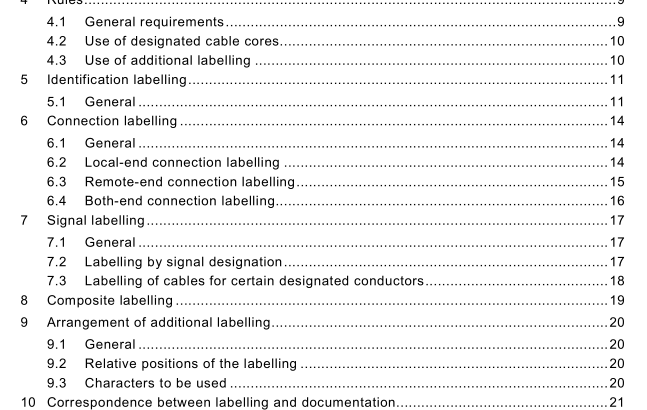IEC 62491:2008 pdf download – Industrial systems, installations and equipment and industrial products – Labelling of cables and cores
5 ldentification labelling5.1 General
The purpose of identification labelling is to show the identifier of the cable or core as aconstituent of the system of which it is a part.The same labelling is valid and may be used allalong a cable or core, even if it has junctions in its run.
The identification labelling does not provide any information on the connection. Theconnection information is in its entirety to be found in associated documentation.
NOTE1 For further information on the preparation of the relevant document types,see lEC 61082-1.
The preferred identifier of a cable or core is a reference designation in accordance withIEC 81346-1. That standard provides further guidance on how to create unambiguousreference designations within an installation, system or equipment.
The reference designation can take different forms depending on, in which structure the coreis identified and to which object the core is associated.
NOTE 2“Cable numbers” are considered as a kind of reference designation. For further information,see lEC 81346-1.
The reference designation should normally be shown with relevant prefix sign, but this may beomitted if no ambiguity can arise.
NOTE 3 ln the examples of this standard the first prefix sign of the reference designations (even if named“complete”) has been deliberately omitted in order not to give a reader the impression that a specific one isrequired for cables and connections.
EXAMPLE 1:
Cables between terminals belonging to the same object within which cable or core areidentified.See Figure 1 and Table 2.The labels at each end as well as possible intermediatelabels are shown.
. w23 is a single core cable with end labels and an intermediate label;
. W24 is a cable with end labels and intermediate labels.Also,the labels of each core of
this cable are shown in the example. Note that the additional labelling of the cable corescould be omitted if the cable cores are unambiguously designated by numerals or coloursby the cable manufacturer as described in 4.2.
The initial part of the reference designation identifying the object within which the labelling is required to be unambiguous may be omitted if no ambiguity can occur. This requires that the reference designation of this object is clearly shown on a label related to that object.
NOTE 4 The complete reference designation of the cable or core is still the concatenation of the reference designation of the object and that of the cable or core. EXAMPLES 2 (see Figure 2 and Table 3): If the object of which the cable core is completely a constituent has a reference designation A1 B2C3D4 and if the cable core is connecting two terminals within this unit, then the core labelling could be abbreviated to W23 while the full reference designation of that core is A1 B2C3D4W23.
If the core is crossing border lines between objects, the full reference designation that is relevant in this case needs to be presented on the label. For example the core connecting terminal block X1 inside A1 B2C3D4 and terminal block X1 inside A1 B2 is identified with respect to the object of which it is completely a constituent (i.e. A1 B2) by A1 B2W23.
6 Connection labelling
6.1 General
The purpose of connection labelling is to show, by means of the terminal designation, the identifier of the terminal to which the cable or cable core is (to be) connected.
For a multi-core cable it may only be possible to show the identifier of the terminal block or of the equipment to which the cable is to be connected.
The preferred identifier for a terminal is a terminal designation in accordance with IEC 61 666.
That standard provides further guidance on how to create unambiguous terminal designations within an installation or system.
